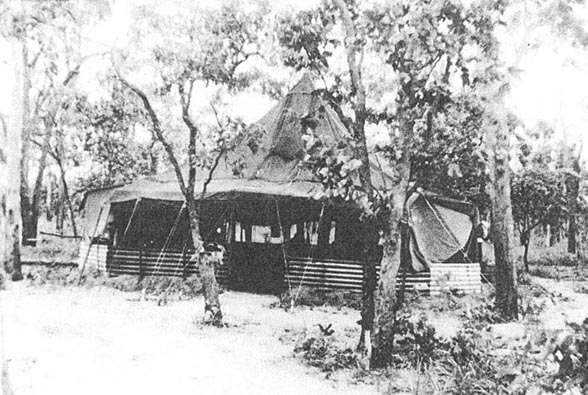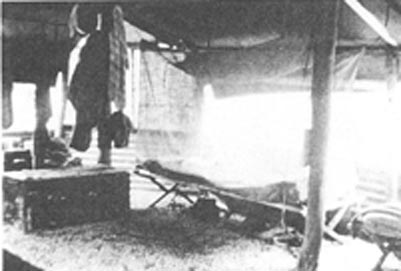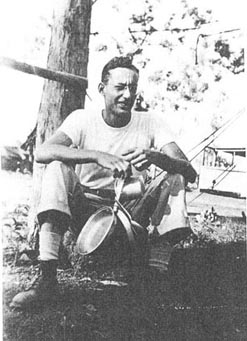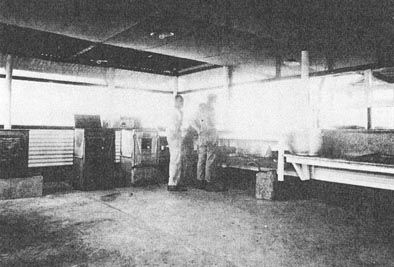380th Bomb Group Association
Newsletter 33 ~ Winter 2007/2008
|
380th Bomb Group Association Newsletter 33 ~ Winter 2007/2008 |
DREAM TIME - A WAR STORY
INSTALLMENT #5
by Robert W. Caputo
This is a story of one person's experience in World War II and the title grows out of the time served on the Continent of Australia (the term "Dream Time" is borrowed from the Australian Aborigine use of the term to describe the distant past of mankind). The writing was done because of the urgings of one family member and was completed in 1995. No claim is made that the story is one of a kind or especially unique, no more than each of us is some different from the other. Reproduced here by permission of the author.
Because of the length of the manuscript, we will tell Roger's story in various installments, in succeeding issues of THE FLYING CIRCUS Quarterly, as page space permits.
Roger Caputo was an NCO who was assigned to Group Headquarters, Administrative Section, in Intelligence.
It was a 100 miles ride over rough gravel roads from Darwin to Fenton Field
where Headquarters and two squadrons were to be based. The other two squadrons
had to travel still another 100 miles further south to another airstrip called
Manbulloo.
These bases plus decoy bases had been hacked out of the "Outback" by Aussie Army
Engineers and they stayed on to maintain them and build our camp facilities. The
mess halls and office buildings were wooden framed with the wood being cut on
the job with portable saw mills. The covering was corrugated sheet iron. There
were no glazed windows, only fold-out louvers to let in the air and keep out the
rain which came continuously during the rainy season (the winter months of May
through September). Leather shoes would become covered with green mold and
clothing seemed to never dry. The dry season was just the opposite: it seldom
rained and when it did, it always fell out of a thunderstorm. During the dry
season the "Outback" would become dry as tinder and brush fires were common. The
insects were never too bad, but we always slept under a mosquito net and we took
our daily dose of medicine to ward off the yellow fever. The medication gave all
of us a yellow-tinged complexion.
Home was a five-man tent with no floors and the sides were kept raised most of
the time for ventilation. Other trimmings, such as a 2-foot high sheet of
corrugated iron around the outside of the tent, served as a barrier against
creepy crawling things such as lizards or snakes. One never went to bed at night
until the bed was shaken down to flush out the scorpions or centipedes. Shoes
were never put on in the morning until they had been shaken out. There was
running water from an elevated water tank which in turn was kept filled from
bored wells by pump. The showers and wash stands were community affairs with no
privacy or screening.
 Home Sweet Home, Fenton |
 The bedroom! |
 The "private" bathroom |
 "What's for chow?" |
 Doin' the laundry |
 The EM's mess; looks bare! |
The Red Cross girls had to look out for themselves and never wandered into our
area. There is always a pecking order to human relations. The Headquarters
section was located on a small hill. At the top of the hill were the quarters of
the Red Cross girls enclosed by a stockade made from whatever was available.
Next down the hill were the officer living quarters followed by the HQ building.
Last at the food of the hill were the mess hall and the enlisted men's living
area. Enlisted men were strictly prohibited from approaching the Red Cross
stockade as they were not "gentlemen" and therefore not trustworthy! After one
look at some of the Red Cross girls, it was obvious the enlisted men were not
being penalized! The Red Cross's principle function was to serve the aircrews
coffee or pastry when they returned from their missions. They were also supposed
to be available to help with family problems back home. From time to time, the
officers and Red Cross girls threw parties for each other and the sounds of
reveling would drift down the hill on the evening breezes. In the eyes of the
excluded enlisted men, it was the rankest kind of discrimination. We all had a
lasting impression of how some ethnic groups, such as blacks, have been treated.
There was no way to distinguish the days of the week. They were all alike. We
went to our jobs every day at 0700 and knocked off at 1700. On occasion there
was work at all hours of the night and it was the combat mission's schedule that
determined the need for the night work. Usually the missions were flown in the
daylight hours and the airplane mechanics and other service people worked on the
aircraft all night to be ready for the next day's mission. Those people had a
hard life! ... and I at one time thought being an aircraft mechanic might have
been great! During the hot dry season an airplane sitting out in the hot sun
would be too hot to touch so the work was often done at night as the only
practical time.
Reporting to work did not always mean there was something to do for the office
types. We often worked hard at trying to find something to do; to look busy.
These circumstances were bad for morale ... a feeling of being useless and excess
baggage is not a happy circumstance. After awhile, we all started to come to the
office wearing white T-shirts. On one occasion, an officer, new to the Group,
walked in and he did not know whom to address, as our principal officer was not
in and he left in a rage. Soon thereafter, orders came down from the Group
Commander, Col. Miller, that if we didn't think enough of our rank to display it
on a proper uniform, he'd be happy to relieve us of our rank. Next day, we wore
regulation uniforms, long sleeves and all, buttoned up no matter how hot it was.
The Aussies had a little better approach to the uniform and heat problem. Their
standard tropical issue was a short-sleeved shirt and shorts. The American
Military never got the message!
Part of the problem of finding something to do was not of our making. In
consideration of the Aussies' feelings, the 5th AF Command placed us under the
operational command of the Australians. It was they who called the shots on what
to bomb and when in the Dutch East Indies. It was their backyard and they knew
it well. 5th AF had its hands full trying to keep up with General MacArthur who
in turn was competing against the Central Pacific Command for priorities and
recognition.
The Aussies had a good intelligence service. They had installed a network of
spies called "coast watchers" hidden in the hills of the territory occupied by
the Japanese and they would feed timely information on Japanese movements by
short-wave radio. Some of them lost their lives. The Aussies received this
information, processed it, and selected targets to be bombed accordingly. It was
a good arrangement and the logical chain of command was from the Aussies to our
Group. This arrangement largely made the S-2 section, in which I served,
unnecessary as all we did was to do a paper shuffle. The Squadron S-2 officers
would debrief the aircrews after they returned from the missions; write the
reports and forward them to our Group HQ S-2 Section who in turn would send them
on to the Aussies. On one occasion, I was sent to Aussie HQ for an overnight
stay to get acquainted with the procedures and the personnel. It was a
relatively short trip on the North-South Road and I was furnished a motorcycle
for transportation. I had owned a motorcycle right after high school, so I knew
how to ride one. It was a great change of pace from the dull routine of office
work.
The Aussies in turn lodged one of their sergeants with us. His name was Art
Simpson and we enjoyed his company. He was a fine person. The idea of the
exchange was to get to know each other better. In peace time, Art had served
with the Australian Colonial Service in New Guinea and he had many tall tales to
tell about dealing with the natives. The true natives, or aborigines, in New
Guinea and to some extent in the Australian Outback, were stone age people run
over by the white man's civilization. In some cases these natives would work
with the Japanese who occupied their lands, but the Japanese more often than not
treated them badly as compared to the more enlightened treatment they had
received from the Australians and Dutch before the war. The result was a latent
good feeling toward the white man which in some cases worked in our favor when
it came to sheltering downed aircrews awaiting rescue by submarine or Catalina
Flying Boat.
Colonel Miller, our Group Commander, recognized that maintaining a high level of
morale among the aircrews was important. He decided that the aircrews should be
given some R&R at regular intervals in Sydney. The straight line distance from
Darwin to Sydney was 2,000 miles one way and the aircrews, in turn, would fly
themselves on the trip using a bomber that was no longer fit for combat. They
would be gone for a week which gave them a full five days in the city, and the
other two days were used for travel. The aircrews usually returned fairly used
up after 5 days of riotous living and there was always a question of how fit
they were to fly. There was one disastrous incident. The Deputy Group Commander,
a Major and a West Pointer, was en-route back to Darwin from Sydney with his
crew; they were all tired and fell asleep and the plane was on autopilot. The
airplane flew on and on until it ran out of fuel and they crashed somewhere in
the Outback. No one knew where they were and some search and rescue missions
were organized with several bombers trying to locate them. Most of the route
from Sydney to Darwin lies over uninhabited land and the downed bomber could be
anywhere. After several days they were located and the crew of the crashed
bomber lit a signal fire to show their position. The fire got out of control and
the bomber caught fire and burned to ashes. The crew was eventually rescued,
without injury, and returned to base by a trek overland. The entire matter was
sort of kept under wraps and the poor Major was quietly transferred. That
incident ended the R&R trips to Sydney. Later on a new R&R city was chosen
-- Adelaide
in South Australia, and it was only 1,600 miles away. It was also known as a
City of Churches!
In time the Command decided that ground echelon people should also be given an
R&R opportunity, and we would be sent to Adelaide for a week. We were sent in
small groups, sometimes with a buddy. The first trip to Adelaide, Ralph Finch
was my buddy. Adelaide was a quiet town that rolled up its sidewalks early in
the evening and there wasn't much to do but sit around in the hotel and get
lonesome. Ralph had received a "Dear John" letter from his wife back in
Massachusetts and he was heartbroken and was free to vent his sorrows with the
Aussie girls. I was determined to keep the faith with my Virginia, so socially I
was a fifth wheel. Prior to departing for Adelaide, I sought out the counsel of
the Group Chaplain, a Captain Roark, who was a conservative Baptist Minister. I
presented my social problem to him and he came up with a solution. Somehow the
Chaplain had done some earlier reconnoitering in Adelaide and its church
community and made contacts with people of conservative leanings, including
young women who were waiting for their betrothed to return from the war. He gave
me a name to look up when I got to Adelaide. Those who have never experienced
the trauma of living for long periods in a single gender society are not able to
understand the negative effects on an individual. You finally forget how to talk
to the opposite gender and suddenly are not comfortable around them!
As best as I can remember, the young lady's name was something like Thelma Sandow. She worked in an office of some kind as that is where I had to go to
introduce myself and invite her out to dinner to get acquainted. She was a
typical heavy built English-type girl and wore glasses. It was obvious that her
blood lines were all British. Her home was a sheep ranch about 100 miles by
train north of Adelaide and she stayed with a relative near the edge of the
city. To escort her home required a ride on the tram, and then a few blocks walk
beyond. The trams quit running early, about 10:00 PM and to miss it was
unthinkable as the walk would have been miles back to the downtown hotel. We R&R
types had been warned to avoid walking alone in some parts of Adelaide after
dark. The experience was that some Yanks had been assaulted and robbed when
alone. The attackers were never really identified by type, but the suspicion was
that they may have been some renegade Aussie soldiers bent on revenge against
the flashy Yanks and their fat wallets.
There wasn't much to do in Adelaide. The beach was too far away and besides it
was always too cold. A stroll in the park and the small zoo with some photo
taking was about par for a visit there. But the good bed in the hotel and the
excellent food were a welcome relief from camp life.
As I remember, I had two widely spaced R&R trips to Adelaide during the 20
months I was in Australia. On one of these visits, the Sandow family invited me
to their home on the sheep ranch. The train ride was pleasant through the
rolling hills. The Sandows resided in an old stone house, suggesting it had been
passed down for several generations. Thelma's younger brother, an RAAF pilot,
was home on leave after training and before he departed for duty in England. The
Australians love their horses and the Sandows had several riding horses in their
stable. They insisted we all take a ride together in spite of the fact that I
admitted to having never been on a horse. I was assured they had picked out the
gentlest horse for me. Getting on was no problem; it was staying on that
presented the problem! That horse knew he had a greenhorn in the saddle and he
set out to show the two of us who was in control! As we were riding alongside a
fence row, my mount took the bit in its teeth, lowered its head, and burst into
a high speed sprint. I knew I'd lost all control and concentrated on just
staying on as the horse tried to scrape me off by brushing past the fence posts
such that I was certain one of my legs would be torn off. The brother was good
on a horse and came to my rescue, much to my relief. I was one grateful and
humble Yank and fully acknowledged the facts. The entire affair was a great
embarrassment for me and when the weekend was over I was just happy to slink
back to the Northern Territory. Thelma was engaged to an RAAF pilot already on
duty in England. I hope he and the brother returned home safely as after the
last visit all contact was lost with the Sandow family. The Adelaide visits were
great, but they did have a negative effect in that they increased the heartache
for home!
The 1,600 mile trip to Adelaide was an experience in itself. There was a
midpoint stop at a place called Alice Springs; it is almost dead center of the
continent of Australia where it is all desert. Today, Alice Springs is a tourist
resort, complete with modern motels and swimming pools. In 1943/44, it consisted
of one gravel airstrip and half dozen Quonset huts, those half round things made
of corrugated iron sheeting. We sometimes flew to Adelaide in a DC-3, other
times a bomber was used. The food at the Fenton Base lacked variety and there
was no beer in Northern Territory unless it was brought in by air or sea. A
railroad existed from the South Coast to Alice Springs, but then north of Alice
Springs to Darwin there existed only 800 miles of gravel road; dusty in the dry
season and muddy in the wet. After the war was begun the road was maintained
such that trucks could use it, but it was no interstate highway. The stop at
Alice Springs was always welcome as the 1,600 mile trip required about 10 hours
by air. On some occasions a bomber's bomb bay would be rigged out with a wooden
bottom and at Adelaide the entire bomb bay would be loaded with beer in quart
glass bottles and other good stuff. The Adelaide airport had no paved runways;
it was an all-grass field which was typical of an undeveloped area. Those
bombers with their specially fitted bomb bays were called "Fat Cats." One
particular "Fat Cat" mission was loaded at Adelaide and took off then returned
to give the town a buzz job. Some aircrew member undoubtedly trying to impress
his girl. For that time a 30 ton 4-engine bomber roaring across the roof of a
house doing 200 mph at 200 feet was an attention getter. At the end of the low
level run, the bomber pulled up sharply (always impressive) and then the laws of
centrifugal force took over; the temporary wooden floor gave way and the cargo
of goodies went flying completely through the bomb bay doors and was scattered
all over Adelaide! The local Adelaide paper, which we were later to see, carried
headlines of being bombed by friendly forces using bottles of beer!
More to come!
Return to Newsletter #33 Topics page
Last updated: 22 May 2014